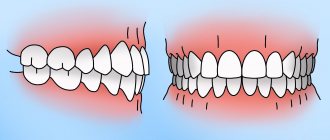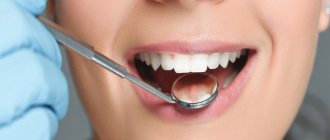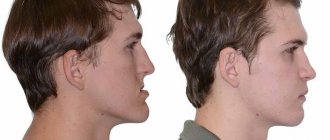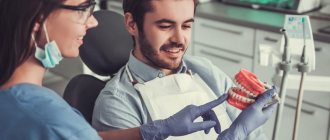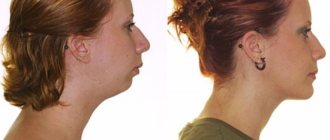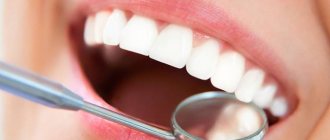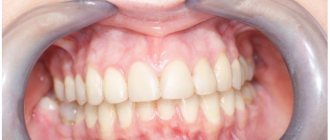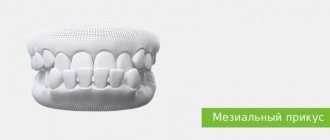An even row of teeth is a sign of beauty and health. Although many people dream of a Hollywood smile only for aesthetic reasons, in fact, a correct bite is very important for the whole body. Therefore, dentists recommend resorting to orthodontic correction immediately after identifying a problem. Protruding teeth can be either a congenital defect or an acquired one. Modern medicine has something to offer in both cases.
Causes of protruding teeth
Most often, the two central teeth protrude forward due to the large grouping and strong pressure of the dentition. Also, the reason may be their initially incorrect position. But it is possible that there is a malocclusion after correction. Many people who wear braces experience a similar problem: protruding front teeth.
There are several causes of the pathology:
- 1. Premature cessation of treatment. External improvements do not always mean full recovery. When braces are removed prematurely, the central teeth gradually move forward.
- 2. Failure to comply with doctor's recommendations. Unauthorized cessation of alignment naturally leads to the return of bone tissue to its original place.
- 3. Incorrect installation of braces. It is possible that the arc tension is insufficient or certain anatomical features of the patient are ignored.
- 4. Rare visits to the supervising orthodontist. Throughout the entire correction period, it is important to make changes and also monitor the design of the braces, which can break without a person noticing.
5. The most common reason for protruding front teeth is ignoring the retention period. After the braces are removed, the treatment does not end, but continues. Every competent doctor knows how important it is to consolidate the result. A frivolous attitude and refusal to further consult an orthodontist will inevitably lead to the return of previous defects.
Big teeth or not: how to determine?
The normal physiological size of teeth has clear boundaries. The central upper incisors, which most often seem too large to their owners, should be from 9 to 13 millimeters in length in an adult, depending on height. The lateral incisors are usually 2 millimeters shorter. As for the ratio of the width and height of the dental crown, ideally it is 1.25%, and the lower this figure, the larger the teeth are considered. However, do not panic if your parameters differ from ideal ones: macrodentia is diagnosed when the size of the teeth exceeds the norm by at least 1.5 times.
Macrodentia can be absolute or relative (individual). The absolute sum of the width of the crowns of the four upper incisors reaches 35 millimeters, and the lower ones – 27 millimeters. If this number is 1 - 2 millimeters less, then the pathology is relative.
Methods for eliminating the defect
Direct veneers or crowns can be used to correct protruding teeth. But this method is more of an aesthetic nature. It does not solve the problem at the root, but only masks it. Veneers are suitable if one or maximum two teeth are protruding.
To correct the bite, it is recommended to use braces. The disadvantage of this treatment is the long period. But the advantages are invaluable, because as a result it is possible to correct the location of each individual tooth.
In some cases, several teeth may have to be removed. This is done when there is a lot of crowding and there is no space for straightening the teeth.
If the central teeth protrude after wearing braces, a different treatment system is used.
During the so-called retention period it is recommended to use:
- removable retainers;
- fixed retainers.
Which type to choose depends on the complexity of the curvature. If it is minor, removable mouthguards are used. They are plastic overlays that perfectly fit the shape of your teeth. Mouthguards are made individually, based on an impression. If it is necessary to strengthen the structure, wire is installed in the retainers. The orthodontist develops a plan for wearing mouth guards.
Fixed retainers are metal arches. They are attached to problem areas and cannot be removed. Fixation occurs on the inside of the teeth, so the patient does not feel discomfort when wearing them. The duration of use of the arches, as well as their shape, is selected individually.
Unfortunately, the problem of protruding teeth cannot always be solved with veneers or braces. If long-term correction does not give the desired result, the doctor may recommend using the Herbst apparatus. The non-removable design corrects even very complex defects in just 1 year. Changes are visible immediately after its fixation. The Herbst appliance gradually moves the upper jaw backward and the lower jaw forward.
Correction of misaligned teeth
What to do if you see, for example, how the teeth on the lower jaw have shifted?
It seems to many that it is no longer possible to correct the situation in adulthood - the teeth will still return to the wrong position, and besides, correcting the bite is long, difficult and unaesthetic. Fortunately, orthodontists today are successfully correcting misalignments in adult patients. To do this, they use 2 orthodontic systems, which, using the pressure of a calculated force, carefully move the teeth to the correct position.
- Braces
A classic non-removable system that consists of a metal arch, braces - elements that are fixed to each tooth, and locks or ligatures that secure the arch in the braces. Today, these systems have become much more compact and comfortable, and we are no longer talking about long years of correction, since the average treatment period is only 1.5–2 years. Doctors have metal, ceramic, sapphire and combined systems at their disposal. There are also lingual braces - they are fixed on the lingual side of the teeth and are not visible when you smile. - Aligners
A removable system of aligners developed about 3 years ago that are worn on the teeth. For each patient, based on photographs and impressions of the jaws, an individual set of aligners is created, which the patient himself changes according to a schedule drawn up by the orthodontist. Unlike braces, aligners can be removed for 2 hours a day to eat and brush your teeth.
However, in any case, after removing the orthodontic system and completing the bite correction, a period of retention follows - when the patient wears retainers that prevent the teeth from returning to their previous position.
Consequences of malocclusion
If the defect does not create physical inconvenience, then you can ignore it. This is a misconception held by many people who experience protruding front teeth. In fact, this is not only an aesthetic flaw.
Incorrect bite leads to very disastrous consequences, various kinds of complications affecting all organs and systems.
Here are some of them:
- 1. Accelerated tooth decay. Uneven chewing load leads to grinding of incisors, formation and development of caries.
- 2. Deformation of the facial part of the skull. An aesthetic defect that affects the beauty of a smile, the appearance of the profile.
- 3. Disruption of the gastrointestinal tract. With an incorrect bite, chewing food is not of sufficient quality, which leads to diseases of the digestive system.
- 4. Development of periodontal disease. Inflamed gums cause physical discomfort. In addition, they can cause tooth loss.
- 5. Impaired functioning of the temporomandibular joint. If the problem is ignored for a long time, neuralgia and arthritis develop.
Protruding front teeth are the tip of the iceberg, underneath which lies a huge number of problems. The consequences of malocclusion worsen over the years. They concern not only the oral cavity, but the whole body. With protruding front teeth, beautiful diction and correct articulation are impossible. In addition, they can make breathing difficult. If the bite is incorrect, prosthetics become more difficult.
What is distal bite (occlusion)
This is a pathology in which the upper jaw is not located at the same level as the lower jaw, but is significantly pushed forward, as a result of which the teeth close incorrectly, with displacement. And not only the front ones, but also the lateral ones, which creates a block that prevents the healthy development of all incisors.
It arises and develops as a result of one, several or a whole group of interrelated factors (discussed in detail below), which entails other anomalies, most often diastema. Over time, it also causes weakening of the chewing muscles, respiratory problems and other complications that are dangerous to the body.
Preventing protruding teeth
It is easier to prevent any problem than to treat it. Therefore, at the first signs of dental deformation, it is recommended to consult a doctor.
To achieve a positive result you must:
- 1. Correctly use braces, veneers, Herbst apparatus and other modifications of orthodontic devices. Do not remove them ahead of time and if you suspect a violation or breakdown, immediately contact a specialist.
- 2. Listen to your doctor's advice. The orthodontist sees the big picture, so he or she will know better which treatments to use and for how long. It is important to attend all appointments to ensure timely adjustments to the devices and monitor changes.
- 3. Provide a psychologically healthy climate. Stressful situations, poor sleep, excessive physical and mental stress negatively affect all organs and systems, including bone tissue that needs to be corrected.
- 4. Eat right. A balanced diet and the intake of vitamins and minerals have a positive effect on regeneration processes in bone tissue and help eliminate malocclusions.
Beautiful teeth are not always a gift from nature. Most often, the painstaking work of an orthodontist is hidden behind a Hollywood smile. It is necessary to understand that the older the patient, the more advanced the problem, the longer it will take to correct the defect. After 25 years, processes in bone tissue slow down. Therefore, if there is such an opportunity, you need to start treatment in childhood or adolescence.
Also, we must not forget about the retention period. It lasts no less than the period of wearing braces. Consolidation of the result is necessary, because otherwise the ligaments will return the teeth to their original place. Thanks to the methods of modern medicine, the process of teeth straightening occurs relatively quickly and painlessly.
How to correct a protruding jaw?
It is possible to correct a protruding upper or lower jaw, but it is worth keeping in mind that this is a long process that will require time and effort. The easiest way to correct a protruding jaw is in childhood: bones that are in the process of growth are easier to manipulate. In adults, correction of the mesial bite can take several years.
All treatment methods can be divided into three categories.
Gentle treatment - mainly used to correct protruding jaws in children under 12-13 years of age. As a rule, it involves inhibiting the growth of one of the jaws and stimulating the development of the other.
- Massaging the bone of the alveolar ridge is a stimulating effect that accelerates the development of the jaw.
- Wearing orthodontic structures - mouthguards, braces and trainers. Removable structures (trainers or LM activators) are effective starting from the period of primary occlusion. They can be used in the preparatory period before installing braces, thereby reducing the time of orthodontic treatment.
- Myofunctional gymnastics aimed at training the facial muscles. Orthodontists recommend starting to do such exercises for children from 2.5 to 3 years old, which will normalize maxillofacial development.
- Using vestibular plates to combat bad habits. Such techniques are used for primary and mixed dentition (aged 3 to 9 years), they are necessary to eliminate myofunctional disorders in the growing body. At the same time, the effectiveness of the exercises significantly increases (daytime training for 1 - 2 hours and wearing the device at night).
Orthodontic treatment
- This is a gradual correction of the position of the jaw using special devices that must be worn every day for a certain time (or constantly). In addition to the well-known brace systems (read more about braces in the article), more complex designs can be used. They change the direction of bone growth, pull the “lagging” jaw forward, expand the dentition, align and move teeth in the right direction. There are intraoral and extraoral systems. They are quite effective, but wearing them is associated with certain restrictions.
Surgical treatment
— surgical correction of a protruded jaw.
- Plastic surgery (trimming) of the frenulum of the tongue is prescribed for children 5-6 years old and can effectively correct the bite during the period of changing teeth.
- Tooth extraction helps reduce the size of an overdeveloped jaw.
- Osteotomy is a radical way to get rid of a protruding jaw. Prescribed to patients over 18 years of age when other methods are ineffective or have failed. During the operation, the jawbone is sawed, placed in the desired position and fixed with titanium structures. Read more about orthoganic surgery here.
Diagnostics
Diagnosis of pathology includes not only identifying an abnormal bite, but also determining the cause of its occurrence. To accurately assess the condition of the jaw system, a set of measures is carried out:
- Teperentgenography. Thanks to the procedure, the doctor identifies existing defects in the jaw bones and also assesses the condition of the alveolar processes.
- Tomography. It is prescribed to determine the localization of the head of the mandibular joint.
- Casts. Models are used to study the structural features of bone tissue elements.
- Electromyography. Prescribed when analyzing the chewing functions of the jaw.
- Study of the dentition using the Schwartz method. The technique allows you to identify a type of abnormal bite.
- test . Another way to determine the type of pathology.
Symptoms and manifestations
If pulpitis is diagnosed by acute pain upon contact with cold or hot food, then the characteristic symptoms of periodontitis are painful tapping or pressing on the tooth.
This diagnosis may be indicated by:
- swelling of the cheek or gum near the tooth;
- a feeling of fullness in the tissues of the organ;
- the occurrence of a fistula with the outflow of pus into the oral cavity;
- increased pain when eating or pressing on the causative tooth;
- the feeling of an “overgrown” tooth (due to compaction of the tissues under the root, the organ begins to bulge);
- pulsation in the root area;
- increased temperature in the area of the causative tooth.
The chronic type of this disease can be asymptomatic and detected only with the help of an X-ray examination. Therefore, the insistent recommendations of the dentists of the LeaderStom clinic to undergo a dental examination by a doctor once every six months are so important for the early detection of such diseases.
Crowding
The most common drawback. Its reason is the narrowing of the upper dentition and lack of space for all the teeth. Wisdom teeth have already become a rudiment (a functionally unnecessary organ), so most people can only accommodate 14 teeth in their upper jaw. If the fifth and sixth teeth begin to erupt, then the entire row is forced to make room. This is where crowding comes from. Due to individual characteristics, sometimes even 12 teeth cannot erupt smoothly without running into each other.
Crowded teeth
Therefore, dental expansion is included in most orthodontic treatment plans. This change has a positive effect on both the smile and the face: the oval of the face and chin tighten and become clearer.
Periodontitis by location
There are two main divisions in the classification of periodontitis based on the location of the disease: apical and marginal. The first option (apical) is also apical, based near the apex of the tooth root. This type is the most common, since periodontal infection in most cases occurs through a descending channel: from caries to inflammation of the pulp, and then through the root canal the infection descends into the periodontal tissue. This process most often becomes chronic, since the protective mechanisms of the periodontium are much more powerful than those of the pulp. Therefore, the infection can enter the deep tissues of the tooth for years without causing signs of disease.
Marginal chronic periodontitis is located on the lateral walls of the tooth root and has the etiology of microtraumas.
Periodontitis, the treatment stages of which are a complex, complex process, requires immediate attention to a dental clinic. It is safe to say that such a diagnosis requires highly qualified specialists with extensive experience in solving such problems. Dentists of the LeaderStom network of clinics are rightfully considered the best in this area of dental therapy. The latest technologies, progressive techniques and extensive practice allow them to cope with the most complex, advanced cases.
Rotation
Twisting of teeth around a vertical axis often occurs in children who, during teething, suffer from bad habits: licking or biting their lips, sticking out the tip of their tongue. Teeth that have just erupted are pliable and easily take on the wrong position. Rotation also occurs due to lack of space, so it is more likely to affect those who have naturally large teeth. Therefore, during rotation, jaw expansion is also necessary.
Rotated teeth
